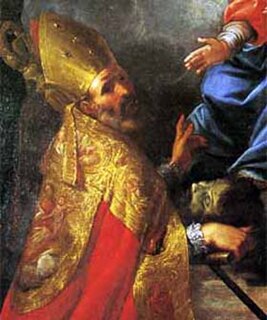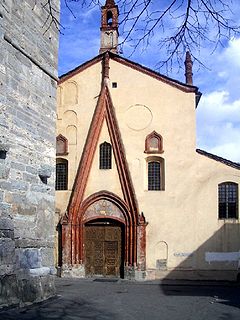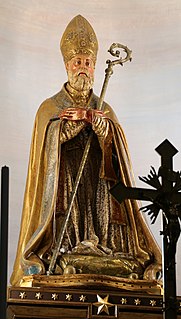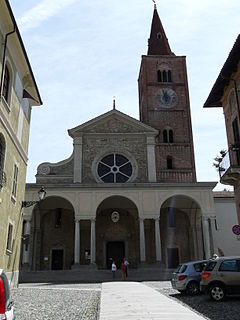Related Research Articles
Pope Boniface IV was the bishop of Rome from 608 to his death. Boniface had served as a deacon under Pope Gregory I, and like his mentor, he ran the Lateran Palace as a monastery. As pope, he encouraged monasticism. With imperial permission, he converted the Pantheon into a church. In 610, he conferred with Bishop Mellitus of London regarding the needs of the English Church. He is venerated as a saint in the Catholic Church with a universal feast day on 8 May.
Year 1243 (MCCXLIII) was a common year starting on Thursday of the Julian calendar.
Humbert III, surnamed the Blessed, was Count of Savoy from 1148 to 1188. His parents were Amadeus III of Savoy and Mahaut of Albon. He ceded rights and benefits to monasteries and played a decisive role in the organization of Hautecombe Abbey. It is said that he would rather have been monk than a sovereign. On the death of his third wife he retired to Hautecombe, but then changed his mind and, by his fourth wife finally had son, Thomas. He sided with the Guelph party of Pope Alexander III against the Ghibelline Emperor Frederick Barbarossa. The result was an invasion of his states twice: in 1174 Susa was set on fire, and in 1187 Henry VI banished him from the Holy Roman Empire and wrested away most of his domains, of which he was left only with the valleys of Susa and Aosta. He died at Chambéry in 1189. He was the first prince buried at Hautecombe. His memorial day is March 4.

Aosta is the principal city of Aosta Valley, a bilingual region in the Italian Alps, 110 km (68 mi) north-northwest of Turin. It is situated near the Italian entrance of the Mont Blanc Tunnel, at the confluence of the Buthier and the Dora Baltea, and at the junction of the Great and Little St Bernard Pass routes.
Boniface is a given name and a surname. The best known of those who bear the name is Saint Boniface, an important leader in early Christianity and the "Apostle of the Germans". Others named Boniface include:

Canavese is a subalpine geographical and historical area of North-West Italy which lies today within the Metropolitan City of Turin in Piedmont. Its main town is Ivrea and it is famous for its castles.

The Roman Catholic Archdiocese of Turin is an ecclesiastical territory or diocese of the Roman Catholic Church in Italy.

The Roman Catholic Archdiocese of Vercelli is a Latin rite Metropolitan see in northern Italy, one of the two archdioceses which form the ecclesiastical region of Piedmont.

Saint Gratus of Aosta was a bishop of Aosta and is the city's patron saint.

The Collegiate church of Saint Ursus is a collegiate church in Aosta, northern Italy, dedicated to Saint Ursus of Aosta.

SaintUrsus of Aosta was an Italian evangelist, today venerated as a saint.

Pancras or Pancratius is an Italian saint associated with Taormina and venerated as a Christian martyr. His surviving hagiography is purely legendary. He is, however, recorded in some early martyrologies.

Saint Catellus of Castellamare was a bishop of Castellamare di Stabia. He was a close friend of Saint Antoninus of Sorrento. Tradition states that Antoninus, fleeing the Lombard invasions, headed for Campania where he ended up at Castellammare di Stabia. Here Catellus was bishop but wishing to become a hermit, gave up his office as bishop and entrusted Antoninus with the task of serving as the town's bishop. Catellus withdrew to Monte Aureo.

The Italian Catholic Diocese of Aosta has existed in its modern form since 1817. It is a suffragan of the Archdiocese of Turin.
Émeric de Quart, born in the latter part of the 13th century at the castle of Quart in the Aosta Valley, was Bishop of Aosta from 1302 until his death on 1 September 1313. He is more frequently named in ancient documents as Eymericus than Emericus or even Aimericus.

The Italian Catholic Diocese of Ivrea is in Piedmont. For a time the diocese included the territory which had once been the diocese of Aosta, suppressed in 1803 but restored in 1817. Up until 1517 Ivrea was a suffragan of the Archdiocese of Milan; it is now a suffragan of the Archdiocese of Turin.

The Roman Catholic Diocese of Acqui straddles the (civil) regions of Piedmont and Liguria, in northwest Italy. The ancient Roman name of the place was Aquae Statiellae, which was sometimes confused with Aquae Sentiae (Aix-en-Provence), and Aquae Augustae (Dax), where there were also bishops. Acqui had always been subordinate to the Province of Milan, down until 1817, when Pope Pius VII assigned it to the Province of Turin. As a suffragan of the Archdiocese of Turin, it falls within the ecclesiastical region of Piedmont.
Saint Chiaffredo is venerated as the patron saint of Saluzzo, Italy. Tradition considers him a member of the Theban Legion, but instead of being martyred with this legion at Agaunum, he escaped to Piedmont and was martyred there.
Saint Bessus, sometimes Besse, is venerated as a member of the legendary Theban Legion, whose members were led by Saint Maurice and were martyred for their Christian faith in the 3rd century. Except for St. Maurice's cult, veneration for Bessus enjoyed a wider popularity than those associated with other saints of the Theban Legion and remains popular today. According to tradition, Constantius survived the decimation of his legion and fled to valleys of Aosta and Cogne. He then dedicated himself to converting the people in this area to Christianity.

The Collegiate Church of Santa Maria della Scala in Chieri is a late-Gothic Roman Catholic collegiate church, and the principal church or duomo, in the town of Chieri, Province of Turin, region of Piedmont, Italy.
References
- ↑ Arduino, Fabio (2005), "Beato Bonifacio di Valperga", Santi beati e testimoni (in Italian).